We gathered hundreds of recommendations from a wide range of practitioners. We synthesized these into the following five top-level recommendations that we feel apply to all actors across the ecosystem. Targeted recommendations for specific audiences (Tech Practitioner Orgs, Other Orgs, Individual Practitioners, Funders, Educators, and Government) are available in tables at the end of each of the five top-level recommendations.
1. Nothing About Us Without Us: Adopt Co-Design Methods and Concrete Community Accountability Mechanisms.
The design of tech projects must involve people from the communities they are meant to serve, early on and throughout the design process. This was mentioned by more than half (52%) of participants. Actors across the ecosystem, including government, private sector, and nonprofits, all increasingly understand how important it is to authentically engage community-based organizations at all design stages of tech projects. This common understanding should be made more visible, and concrete methods for community engagement and accountability should be shared across the field.
Adopt co-design methods. Co-design means spending time with a community partner, in their space, learning about needs, and working together through all stages of design. Usually, no new tech development is necessary to address the most pressing issues. Co-design methods have a growing practitioner base, but could be better documented and supported.
Develop specific, concrete mechanisms for community accountability. Nearly all interviewees said that the people most affected by an issue have to be involved throughout all stages of any tech project meant to address that issue. All actors in this field need to move from stating this as a goal towards implementing specific, concrete accountability mechanisms. For example: funders should require written community accountability mechanisms from their grantees, and educators should center community accountability in education programs.
Center community needs over tools. Community needs and priorities must drive technology design and development, and technology is most useful when priorities set by those who are not technologist. “Be humble, and respect community knowledge” (Rashmi, Director of Tech at a Civil Rights Org). Process and solution should be driven by the community; do not make community members token participants.
Invest in education (both formal and informal) that teaches co-design methods to more practitioners. Support existing efforts in this space, create new ones, and push existing educational programs, institutions, and boot camps (such as those listed in our Educational Programs Spreadsheet: http://bit.ly/t4sj-programs to adopt co-design perspectives and practices.
Create tech clinics, modeled on legal clinics. Public interest law and legal services work are client-oriented, and lawyers doing this work constantly interact with people who need to navigate larger unequal systems. This is considered part of their legal education. Tech can learn from this model.
Create fellowships to spread co-design methods across multiple fields, not only in tech, but in other areas as well, such as legal services.
Do real usability testing, and create Community Research and Design Boards. Usability testing with real world users is essential to validate assumptions and improve applications, services, and UX.23 In addition, consider creating additional mechanisms for broader oversight, such as Community Design Boards for technology design projects, similar to the recent implementation of Community Review Boards for research projects (and/or, expand the capacity of existing Community Review Boards to review technology design projects).24
Avoid “parachuting” technologists into communities. In general, parachuting is a failed model. Don’t do it. Stop “parachuting” technologists into organizations, or focusing on isolated “social good” technology projects, devoid of context, when the real need is capacity building (Mel, Executive Director at a Nonprofit). This does not mean “never bring someone in from outside a community.” It depends on what the community wants, and what the person parachuting in is doing: are they building capacity, or are they creating a vacuum? We do think that it is worthwhile to develop better models for sharing local knowledge with national groups, and for national groups to share their perspective with local groups in ways that benefit all parties.
Stop reinventing the wheel! Well-meaning technologists often reinvent the wheel, without researching existing solutions. Designers, developers, and project leads, no matter what sector they are in, should begin projects by researching existing projects and organizations (Elioenai, Civic Tech Head at a Tech Corporation and Martha, Lead of Acquisitions at a Government Office). This also stems from competitive, rather than collaborative, mindsets (“ours will be better, so we’ll just compete”). It is important to work together to develop shared tools and platforms, instead of perpetually competing for scarce technology resources.
Support maintenance, not just “innovation.” Significant resources are necessary to maintain and improve existing movement tech, but most focus is on the creation of new projects. We need more resources to update, improve, and maintain already proven tools.
Additional Related Recommendations:
- Gather data about community-led design and create a (public) mechanism to track and share community accountability in tech projects.
- Participatory research (PAR) and participatory design (PD) are key approaches to developing meaningful, useful, accountable tech projects with community buy-in. PAR and PD should be mainstreamed across the field, along with UCD and agile development methods.
- Make it a goal to involve people without tech backgrounds into tech projects; this may help “abolish” the “tech bro” mentality.
AUDIENCE-SPECIFIC RECOMMENDATIONS
 Tech Practitioner Orgs
Tech Practitioner Orgs
|
|
 Other Orgs
Other Orgs
|
|
 Individual Practitioners
Individual Practitioners
|
|
 Funders
Funders
|
|
 Educators
Educators
|
|
 Government
Government
|
|
2. From Silver Bullets to Useful Tools: Change the Narrative, Lead with Values, and Recognize Multiple Frames and Terms Across the Ecosystem.
Be clear about values and vision. Regardless of how you or your organization think about the role of technology in social change, it is important to be explicit about your values and vision. For example, for many practitioners we interviewed, social justice is the core value, and technologies are tools to support movements that advance towards social justice. For others, such as many of those working in the public sector, accessibility and efficiency are core values, and tech is a tool to make government services easier to use.
Shine a light on the amazing diversity of people who already work in this ecosystem. It is important to lift up diverse practitioners in the public conversation about this work; it’s not just white cisgender men that work in tech.
Challenge the narrative that tech work lies only in the corporate sector. Emphasize that folks can make a life out of tech work to support themselves, their communities, and their values.
Challenge the narrative that the “most exciting” tech work is only in for-profit startups. Produce and circulate a new narrative about the very wide range of roles, problems, challenges, and opportunities to do tech work in public, nonprofit, and movement organizations.
When circulating jobs, grant opportunities, procurement bids, and other resource opportunities, consider that any frame you choose will make some communities feel more comfortable than others. For example, some women and PoC feel pushed out of “technologist” frames, even if they have tech skills. Certain frames, like civic technology, are predominantly white, male, and U.S.-centric, and are not seen as inclusive spaces for most people.
Acknowledge that technology often reproduces longstanding problems. Don’t erase the fact that new tools and platforms often reproduce longstanding problems. For example, surveillance is not a “new” threat for Black people in America. Listen to, support, resource, and center practitioners from communities that have been dealing with issues for a long time, even if there is a new technological manifestation of the problem.
There is an ecosystem, not a single field. We found that there may not be a singular field that contains everyone who is working with technology for the public interest, common good, and social justice. Our research revealed many related fields, with some individuals and organizations as connectors, and some cohesive elements, as well as differences and silos. It may make more sense to speak of an ecosystem.
Terminology and framing matter. Different terms and frames resonate for different actors in this space. It’s best to understand the range of terms and frames that people are using to do excellent work leveraging technology to advance the public interest, the common good, social justice, government and corporate accountability, and so on. “Public interest technology” and “civic tech” seemed to resonate most with white people and those working inside government, foundations, and larger policy shops. Some of the WoC and/ or LGBTQI people we interviewed do not identify with the term “technologist,” or even have been specifically told they are not “technologists,” especially if they are not computer programmers; they use the language of technology and social justice and community technology, and find other spaces alienating. Just as there is both “public interest law,” “community lawyering,” and “movement lawyering,” we may need both “public interest tech,” “community tech,” and “movement tech.” These may overlap, but are not the same thing (e.g. see Law for Black Lives at www.law4blacklives.org).
Language choices may alienate the people we are hoping to attract. Educate people on how their language choices may alienate people and communities they hope to collaborate with. For example, when circulating job opportunities, grant programs, and other resource opportunities, be aware of these differences and consider that all communities feel more comfortable with some frames than others. For example, some women and PoC feel pushed out of “technologist” frames, even if they have tech skills. Note that this is consistent with research findings that the language used in job postings influences who feels comfortable applying.25
Acknowledge that technology is laden with a value framing that does not always align with the values of the people doing the work. Support and create more resources to help people working in tech develop political lenses on technology, and acknowledge that all work in this space involves politics and takes place in a context of systemic power inequality.
Change the narrative around tech work to highlight alternative paths and center social justice values.
- Emphasize that there are other options for folks in tech work, other paths they can take, and that they can make a life out of doing tech work that supports and advances their communities and their values.
- Produce and circulate a new narrative about the very wide range of roles, problems, challenges, and opportunities to do tech work in public, nonprofit, and movement organizations.
- At the same time, the narrative of “they’re just the IT person” is something that we also feel needs to be challenged. One partner said “the IT people at my organization are doing amazing things, really creative things!” The idea that this work is not appealing or rewarding should also be challenged.
AUDIENCE-SPECIFIC RECOMMENDATIONS
 Tech Practitioner Orgs
Tech Practitioner Orgs
|
|
 Other Orgs
Other Orgs
|
|
 Individual Practitioners
Individual Practitioners
|
|
 Funders
Funders
|
|
 Educators
Educators
|
|
 Government
Government
|
|
3. #RealDiversityNumbers: Adopt proven strategies for diversity and inclusion.
Racism, sexism, classism, ableism, transphobia, and other forms of oppression permeate the tech sector, and the subfields we looked at are not immune. The broader tech sector has slowly begun to pay attention to these problems, but still, diversity and inclusion initiatives are not enough. Our interviewees and project partners have no easy answers for what to do about these massive challenges. Some feel it most important to create our own ecosystem and firms for community autonomy. Others emphasize the need to modify organizational culture using best practices in privilege training and hiring practices, adopt good mentorship practices, and create something like Project Include, but for tech for social justice. In a complex world, all of these strategies and more are necessary. All participants agreed in at least one area: we know that it will be crucial to gather and share demographic data about field participants, and to publicly set equity goals with timelines. Despite recent attention to race and gender disparity in the broader tech sector, this field lacks demographic data. We need key actors in the space, especially the biggest players such as Code for America and the Knight Foundation, to track and share demographic data including race and gender of employees, leadership, and grantees.
Gather and share demographic data about employees, volunteers, leadership, and boards. Tech for social justice organizations should be leading the technology sector in diversity and inclusion. Instead, we don’t even have data that would allow us to make the comparison. We found that very few organizations are tracking the demographics of their staff or volunteers. One of our key top-level recommendations is for all organizations, whether public, private, nonprofit sector, or volunteer, to gather and share demographic data about their employees, boards, and contractors. This would enable us to quantify what many interviewees shared in terms of their own experience: that women, PoCs, and gender nonconforming folks are too often pushed out of the field. For example, Project Include has attempted to do this for the broader tech sector, and we might work with them, or model a similar project on their approach.
- Specifically, the biggest organizations in the space, especially Code for America, the Knight Foundation, the Ford Foundation, and New America Foundation, need to gather and share demographic data about their employees, participants, and grantees. As leading organizations in the space, with big, visible platforms, they can help lead by example, show their values in their practices (“walk their talk”), and set the tone for others.
- We recommend reviewing existing demographic data standards, and adopting a specific standard to be used across the ecosystem.26
- Specific questions to address in gathering demographic data include: who is going to gather this data? What steps do we need to take before that data is published? How can this data advance the goals of social justice orgs?
Create and publicly disclose time-bound diversity targets. It is not enough to simply gather and publish demographic data. Based on demographic data, orgs should set targets, and target dates, for their boards, leadership, and employees to reach demographic parity with the communities they serve.27
Adopt tried and true techniques for inclusive workplaces. Adopt research-based best practices on how to foster inclusive workplaces, many of which apply across fields. Some of these are:
- Create a code of conduct and community agreements to hold people who make the space toxic and exclusive accountable.
- Provide training and resources around community management, to enable more open and inclusive spaces.
- Forefront values, mission, and goals.
- Organize diverse project teams. In addition to being a goal in and of itself, diverse teams choose better ideas and problems to work on, and are more creative and innovative.
- Have privilege trainings and conversations within orgs. Even tech spaces that call themselves progressive or “radical” often fail to have meaningful conversations about privilege. For example, these spaces rarely talk about their own ableism and classism. However, also note that some research shows that poorly implemented privilege trainings can backfire on women, PoC, and T/ GnC people. Provide resources for groups that are known to do this well, such as AORTA, to provide trainings for tech practitioner organizations, as well as in government, nonprofit, and private sector spaces.
- See also the recent Breaking the Mold report by Open Mic: http://breakingthemold.openmic.org.
Inclusive hiring, mentorship, retention, and advancement. Intentionally invest in the hiring, mentorship, retention, and advancement of women, People of Color, and gender nonconforming folks in tech for social justice.
- Change hiring practices. In job listings, orgs should focus more on skills than on degrees. Shift to more skills-based framings, rather than field and identity-based framings. For example, rather than saying you’re looking to hire “a technologist,” say that you’re looking to hire someone who works with technology. Since many people skilled and working in this space never got a formal education in it, shift from requiring computer science degrees to focusing on skills.
- Promote wage transparency. Gather and share wages information about jobs in the field.
- Create and support mentorship programs for underrepresented folks. Several participants suggested a mentorship matching program across the field, as well as support for in-house mentorship.
- Create leadership trainings for women.
- Fund travel.
- Fund paid fellowships and internships (Models are Media Democracy Fund and PHDX internships).
- Practice sponsorship (see http://larahogan.me/blog/what-sponsorship-looks-like.
- Fund programmatic work rather than contractor funding for women and PoC.
- Be cognizant of the financial constraints of rural folks, provide travel funding to rural folks so that they can participate in conferences.
- Support organizations to develop institutional human resources capacity; i.e. someone to have regular check-ins with about well-being, and/or someone who can develop organizational policies to support staff well-being and retention.
- Help people feel supported and sustained through all stages of their path, not just getting them into the field. Build community for tech folks of color working in social justice.
Transform conferences, convenings, meetups, and other gatherings to be far more diverse, inclusive, accessible, and affordable. Support inclusive sites and convenings to foster field growth.
- Face-to-face spaces are still important. For funders and orgs in the space: support and resource physical spaces that create face-to-face interaction, networking, and learning among diverse people. For example, community colleges, universities, and libraries; inclusive hacklabs and makerspaces; and conferences and meetups.
- Document convenings. Thorough and inclusive documentation is important so that those who are not able to attend can still benefit from the learning, examples, and shared knowledge developed at convenings.
- Community colleges may be able to play more of a key role in the ecosystem. Community colleges are low-cost places where people can gain computing skills, often with financial aid. They should develop programs, internships, and other mechanisms to place students in tech for social justice, and funders should resource them to do so.
- Libraries are key sites for this field, but too often overlooked. Libraries reach communities that have been ignored by the infosec and digital security worlds, but who paradoxically live with the highest levels of risk: People of Color, poor people, and/or formerly incarcerated people. Libraries should develop more programs in this field, and should be supported by funders to do so. Recommendation: support programs in libraries related to this field, such as tech classes (Vishnu, Founder of a Nonprofit).
- Hacklabs and Makerspaces can be important to field growth, but are too often exclusive. Support those hacklabs and makerspaces that are doing a better job of inclusion and diversity, like feminist and PoC led hackerspaces such as LOL.
- Meetups at the local level will continue to play an important but sometimes unsung role in field development. Spaces like Netsquared meetups, Tech Resistance, and Code for America meetups, as well as specific regular meetups for women, LGBTQI people, and/or Black people and PoC in the field should all be supported and recognized. At the same time, many tech-focused meetups are replicating gender, race, and class inequalities; systematic outreach to meetup organizers might help.
- Spread the DiscoTech model. Learn from the most community-inclusive event models, such as the DiscoTechs (Discovering Technology events, by the Detroit Digital Justice Coalition).
- Support inclusive conferences. Conferences that are doing a good job of being inclusive should receive more support and visibility. Conferences are still key sites but are often inaccessible to low income people and PoC. Conferences that are good at inclusion, like Allied Media Conference, should be rewarded and grow; those that are failing at this need to change their practices or be replaced by better spaces.
- Create a Diversity/Inclusion Conference Scholarship Fund for the field, specifically for the best conferences, and/or: resource and promote key conferences directly with scholarship funds, specifically conferences that are already known to create good spaces for Women, femmes, Queer and Trans folks, Black/ Indigenous/PoC, immigrants, and/or disabled people. Since conferences are a key point of entry to the field, funders could pool resources to create a diversity/inclusion fund for conference fees and travel support.
- Convene across silos. Create or support convenings that gather people across the various silos of this broader field (Artemis, Technologist, International Policy Technology Nonprofit).
Diversify leadership. Look at the demographics of leadership, and recognize the ways in which that sets the tone for the space. Organizations and funders: Create regular reports on diversity, including diversity of leadership. For funders: consider diversity of leadership as a metric for funding organizations.
Additional Inclusion Related Recommendations
- Women, femmes, and trans people of color specifically are being pushed out of the field. Be sure that both demographic data gathering and sharing, and inclusion initiatives, specifically track progress in attracting, retaining, mentoring, promoting more WoC (Barbara, Manager of a Nonprofit).
- Older people face extra discrimination in the tech sector, despite deep knowledge and capacity for mentorship they may possess (Blair, Fellow for a Legislative Body).
AUDIENCE SPECIFIC RECOMMENDATIONS
 Tech Practitioner Orgs
Tech Practitioner Orgs
|
|
 Other Orgs
Other Orgs
|
|
 Individual Practitioners
Individual Practitioners
|
|
 Funders
Funders
|
|
 Educators
Educators
|
|
 Government
Government
|
|
4. Developers, Developers, Developers? Recognize Different Roles and Expertise in Tech Work, and Support Alternative Pathways to Participation
Technology roles within organizations are diverse, and span a spectrum of skills and issues. Tech work is not performed only, or even primarily, by software developers. The different kinds of roles that are necessary to effectively use tech for social justice need to be made much more visible. It’s also important to not expect the one “technologist” on staff to do everything from general IT support, to design processes, to full stack development.
Create positions for roles such as graphic designer, product manager, community manager, co-design facilitator, researcher, popular educator, in addition to developer when hiring for tech projects across sectors (government, nonprofit, for-profit, cooperative).
Establish support for mentorship. Supportive individual relationships (i.e., in workplace and educational spaces) were mentioned by practitioners more frequently than any other support mechanism as critical to their career path. Create a mentorship matching program, especially to connect mentors that share aspects of lived experience with mentees. Increase support, recognition, awards, dedicated community networks, and other mechanisms to improve mentorship across the ecosystem. Create support, recognition, possibly awards, dedicated community networks, and other mechanisms to improve mentorship in the field (Moses, Digital Security Consultant).
Create paid fellowships and internships that support people from existing organizations, and from marginalized communities, rather than just the one-year parachute model. Create paid opportunities for students of color in other fields, like law, to learn about how tech design processes work.
Create a program for diverse practitioners to visit schools and universities and talk about their career path and work.
Demonstrate pathways specifically into tech for social justice. Make careers in tech for social justice visible in mass media, social media, and popular culture.
Focus on digital equity and popular education to expand the pipeline of people who see themselves as part of the ecosystem. There is a crucial role for people who are able to work as educators in frontline communities that are most affected by the application of digital technologies.
Shine a light on the many roles in tech work. Create template job descriptions to demonstrate the wide range of roles available in this field; for example, many projects might need a software dev, a graphic designer, a community organizer, a project manager, and a design researcher, or other roles.
Encourage people to use different terms that resonate with people in unfamiliar parts of the space.
AUDIENCE-SPECIFIC RECOMMENDATIONS
 Tech Practitioner Orgs
Tech Practitioner Orgs
|
|
 Other Orgs
Other Orgs
|
|
 Individual Practitioners
Individual Practitioners
|
|
 Funders
Funders
|
|
 Educators
Educators
|
|
 Government
Government
|
|
5. Coops, Collectives, and Networks, Oh My! Support Alternative Models Beyond Startups, Government Offices, and Incorporated Nonprofits.
We found that some of the most sustainable, respected, and interesting tech work is being done by groups that do not fall into the standard models of for-profit startups, government offices or agencies, or incorporated nonprofit organizations. For decades, tech cooperatives and collectives have provided key services to many movement groups and nonprofits, such as mailing lists, web hosting, etherpads, and secure communications, often on a shoestring. Informal networks are able to rapidly coalesce during moments of crisis and provide improved information flow, identify priority needs, and organize large numbers of volunteers around tech work with very little resources. Membership organizations also provide tech infrastructure in ways that are accountable to the needs of social movements. All of these and other organizational forms are crucial but less visible forms of tech work for social justice; they should be recognized and supported.
Explore how to help non-501(c)3 organizations, such as B Corporations, worker cooperatives, member organizations, and ad-hoc networks support themselves and provide living-wage jobs for their employees while also doing tech work for social justice.
Provide tech coop development support including incorporation templates, legal incorporation support, operating agreements, and other resources that will help more tech company founders consider coops. These should be standard within tech incubator programs, in university offices that are dedicated to helping create startup spin-off companies, and in municipal initiatives (such as economic development offices) to support new business creation. Many interviewees said that they found the cooperative sector to be a friendlier place for women, PoC, and T/GnC folks. Grow more tech coops that can provide decent paying and stable jobs doing tech work that is values-aligned. Stability, rather than just a high income, is key. For example, we recommend organizational development support to help tech cooperatives buy benefits for their worker/owners.
Provide startup and conversion funds for tech coops, both to help with new tech coop creation, and to support coop conversion of existing companies. We recommend resources that will help more people consider starting tech cooperatives, that more startup founders consider tech cooperatives, and that more existing “tech for good” companies consider cooperative conversion.
Provide rapid turnaround support for ad-hoc networks. Often, especially in crisis moments, ad-hoc and informal networks mobilize very quickly to provide tech support. In many cases, they are more effective than traditional organizations. Develop mechanisms to support such networks.
Leverage ICT Infrastructure projects to grow the ecosystem. These projects can draw together city governments, CBOs, policy folks, and technologists. Successful models from Detroit (DCTP), Philadelphia (MMP), and New York City (Red Hook, Rise:NYC, public housing broadband, etc.) should be supported and widely replicated.
Use government procurement to grow the ecosystem. This requires focused initiatives that can help smaller organizations and companies, women and PoC-owned firms, coops, and others navigate the procurement process.
Study the tech coop sector. The U.S. Federation of Worker Cooperatives is a rich resource for information about tech cooperatives, many of which play very important roles in supporting local movement, nonprofit, and advocacy organizations. They conduct an annual census of U.S. cooperatives, and hold data that could be used to develop a clear picture of what is needed to grow the tech coop sector. We also recommend that the University of Wisconsin Center for Cooperatives conduct a study that focuses specifically on the tech coop sector (see https://mce.uwcc.wisc.edu).
AUDIENCE-SPECIFIC RECOMMENDATIONS
 Tech Practitioner Orgs
Tech Practitioner Orgs
|
|
 Other Orgs
Other Orgs
|
|
 Individual Practitioners
Individual Practitioners
|
|
 Funders
Funders
|
|
 Educators
Educators
|
|
 Government
Government
|
|
